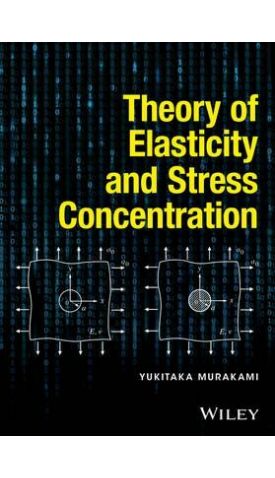אנו משתמשים ב-Cookies כדי לשפר את החוויה שלך. כדי לקיים ההנחיה החדשה של e-Privacy, עלינו לבקש את הסכמתך להגדיר את ה-Cookies. קבלת מידע נוסף.
661.00 ₪
Theory of Elasticity and Stress Concentration
661.00 ₪
ISBN13
9781119274094
יצא לאור ב
Hoboken
זמן אספקה
21 ימי עסקים
עמודים
472
פורמט
Hardback
תאריך יציאה לאור
25 בנוב׳ 2016
Theory of Elasticity and Stress Concentration Yukitaka Murakami, Kyushu University, Japan A comprehensive guide to elasticity and stress concentration Theory of Elasticity and Stress Concentration comprehensively covers elasticity and stress concentration and demonstrates how to apply the theory to practical engineering problems. The book presents a new approach to the topic without the need for complicated mathematics, and the principles and meaning of stress concentration are covered without reliance on numerical analysis. The book consists of two parts: Part I - Theory of Elasticity and Part II - Stress Concentration. Part I treats the theory of elasticity from the viewpoint of helping the reader to comprehend the essence of it. Part II treats the principle and meaning of stress concentration and guides the reader to a better understanding of it. Throughout the book, many useful and interesting applications of the basic new way of thinking are presented and explained. Key features: * Unique approach to the topics. * Encourages the readers to acquire the new way of thinking and engineering judgement. * Includes examples, problems and solutions.
This book provides essential reading for researchers and practitioners in the structural and mechanical engineering industries.
| עמודים | 472 |
|---|---|
| פורמט | Hardback |
| ISBN10 | 1119274095 |
| יצא לאור ב | Hoboken |
| תאריך יציאה לאור | 25 בנוב׳ 2016 |
| תוכן עניינים | Part I Preface for the book Preface for the part Chapter 1 Stress 1.1 Stress at the surface of a body 1.1.1 Normal stress 1.1.2 Shear stress 1.2 Stress in the interior of a body 1.3 Two-dimensional (2D) stress state, three-dimensional (3D) stress state and stress transformation 1.3.1 Normal stress 1.3.2 Shear stress 1.3.3 Stress in an arbitary direction 1.3.3.1 Two-dimensional stress transformation 1.3.3.2 Three-dimensional stress transformation 1.3.4 Principal stresses 1.3.4.1 Principal stresses in two-dimensional stress state 1.3.4.2 Principal stresses in three-dimensional stress state 1.3.5 Pricipal shear stresses Problems of Chapter 1 Chapter 2 Strains 2.1 Strains in two-dimensional problems 2.2 Strains in three-dimensional problems 2.3 Strains in an arbitrary direction 2.3.1 Two-dimensional case 2.3.2 Three-dimensional case 2.4 Principal strains 2.5 Conditions of compatibility Problems of Chapter 2 Chapter 3 The Relationship between Stresses and Strains: The Generalized Hooke s law Problems of Chapter 3 Chapter 4 Equilibrium Equations Problems of Chapter 4 Chapter 5 Saint Venant s Principle and Boundary Conditions 5.1 Saint Venant s Principle 5.2 Boundary conditions Problems of Chapter 5 Chapter 6 Two-Dimensional Problems 6.1 Plane stress and plane strain 6.2 Basic conditions for exact solutions: Nature of solutions 6.3 Airy s stress function 6.4 Hollow cylinder 6.5 Stress concentration at a circular hole 6.6 Stress concentration at an elliptical hole 6.7 Stress concentration at a hole in a finite width plate 6.8 Stress concentration at a crack 6.9 Stress field due to a point force applied at the edge of a semi-infinite plate 6.10 Circular disk subjected to a concentrated force Problems of Chapter 6 Appendix of Chapter 6 Chapter 7 Torsion of a Bar with Uniform Section 7.1 Torsion of cylindrical bars 7.2 Torsion of bars having thin closed section 7.3 Saint Venant s torsion problems 7.4 Stress function in torsion 7.5 Membrane analogy: Solution of torsion problems by using the deformation of pressurized membrane 7.6 Torsion of bars having thin unclosed section 7.7 Comparison of torsional rigidity between a bar with an open section and a bar with a closed section Problems of Chapter 7 Chapter 8 Energy Principles 8.1 Strain energy 8.2 Uniqueness of the solutions of elasticity problems 8.3 Principle of the virtual work 8.4 Principle of the minimum potential energy 8.5 Castigliano s theorem 8.6 The reciprocal theorem Problems of Chapter 8 Chapter 9 The Finite Elemenet Method, FEM 9.1 FEM for one-dimensional problems 9.2 Analaysis of plane stress problems by the finite element method 9.2.1 Approximation of 2D plane stress problems by a set of triangular elements 9.2.2 Relationship between stress and strain in plane stress problemm 9.2.3 Stiffness matrix of a triangular plate element 9.2.4 Stiffness matrix of the total structure 9.2.5 Expression of boundary conditions and basic knowledge for element meshing Problems of Chapter 9 Chapter 10 Bending of Plates 10.1 Simple examples of plate bending 10.2 General problems of plate bending 10.3 Transformation of bending moment and torsional moment 10.4 Differential equations for a plate subjected to loads on the surface and their applications 10.5 Boundary conditions in plate bending problems 10.6 Polar coordinate expression of the quantities of plate bending 10.7 Stress concentration in plate bending problems 10.8 Bending of a circular plate Problems of Chapter 10 Chapter 11 Deformation and Stress in Cylindrical Shells 11.1 Basic equations 11.2 Various problems of cylindrical shells Problems of Chapter 11 Chapter 12 Thermal Stress 12.1 Therrmal stress in a rectangular plate Simple examples of thermal stress 12.2 Thermal stress in a circular plate 12.3 Thermal stress in a cylinder Problems of Chapter 12 Chapter 13 Contact Stress 13.1 Two-dimensional contact stress 13.2 Three-dimensional contact stress Problems of Chapter 13 Appendix Appendix 1 Rule of direction cosines Appendix 2 Green s theorem and Gauss divergence theorem Answers and Hints for the Problems |
| זמן אספקה | 21 ימי עסקים |



Login and Registration Form